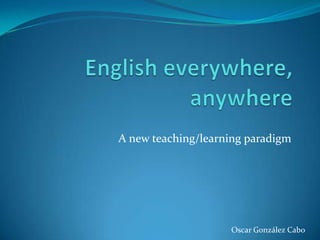
English everywhere, anywhere
- 1. A new teaching/learning paradigm Oscar González Cabo
- 2. The problem Secondary students in Spain can’t communicate in English after, at least, 6 years studying it in Primary school and 4 more year in Secondary school Low motivation Uselessness for their life Lack of self-confidence Obligation of studying it Repetitive language points and grammar Limited communicative methodology
- 3. The objectives Developing communicative skills in English Increase self-confidence Real life to carry out tasks needs Intrinsic Real life Self-study motivation use
- 4. A new framework In-class At home Online Interactive Personal Real life Whiteboard Computers communication Tablets Smartphones Tasking
- 5. The framework (I) We are going to implement an “everywhere” system Presentation of contents in the class Development and use of contents both in the class (tablets), at home (PC) and everywhere (smartphone) The point is: they have to feel the need to use English and do it at their own pace and on their own time Technologically speaking, we need an app or webpage that assigns tasks to the students and keeps track of them
- 6. The framework (II): methodology The teacher introduces the topic in class, explaining the relevant contents (vocabulary, grammar...) The students practice in class with a variety of apps or webpages related to the topic using a tablet The teacher uploads a series of tasks to be carried out by the students, compatible with tablet, PC and smartphone The student executes the task and submits it to the central server for revision
- 7. The framework (III): the server The server pushes the tasks to the student accounts It keeps track of the students’ submissions It’s not a centralised server, they don’t upload their exercises there In order to make it sustainable and scalable, we make use of already available apps (Gdocs, youtube, prezi...) Students perform the task in their preferred app and submit the link to the server (á la MOOC) The server automatically prepares reports for the teacher (daily, weekly, monthly...)
- 8. The framework: the tasks (I) A task is a particular exercise the student has to do providing a specific communicative output It can be read (articles from newspapers, magazines, excerpts from books...) Written (report, presentation, summary...) Listened (radio, tv programme...) Spoken (presentation, report...) Conversational (with classmates or e-pals) Any combination of the above
- 9. The framework: the tasks (II) Tasks will be organised like a videogame Different unrelated tasks that can be done at any time Successfully executing a certain task will unlock new ones After a series of independent (but related) tasks are successfully executed a final task, where all the acquired skills will be required, will be unlocked Students who fail to pass a certain unit, will be pushed said unit by the system to have a chance to review and re-try before delving into the new unit Past tasks will be available for review and improvement
- 10. Technology involved (I) Interactive whiteboards Through the School 2.0 programme, most classrooms are already fitted with one Tablets This is the investment the government should do (considering the current price and the massive acquisition, should be manageable; plus the environment should be introduced progressively, starting from the 1st year)
- 11. Technology involved (II) Personal computers Most houses in here already have one. Free use in public libraries Possibility of lending the laptops from the School 2.0 programme for students from excluded groups Smartphones Most students / parents already have one The tasks, however, should be able to be carried out on PC as well, just in case. They give students the freedom to pace themselves and work on their own time
- 12. Technology involved (III) On the software part, it will be necessary to design a database with an easy and appealing frontend (MOOC-style): Online storage of students’ details and production Storage of units and tasks to be pushed to the student Interface with the student (tablet, smartphone; PC) Possibility of adding a peer-review system, forums, internal messaging once the students c0mmand the main app.
- 13. GOAL Class Home Life
- 14. Implementation (I) Business model It could be applied to any type of model, though the objective here is public education, so non-profit. Implementation Starting from the first Secondary Education year, introduce the framework year by year, progressively Helps prepare the students from scratch Involves a reduced number of teachers (can be just 1) Reduces the amount of investment in devices Allows to foolproof the server and solve issues before scaling up
- 15. Implementation (II) Scaling up Progressively introduce the framework in the next year (2nd year, 3rd year...) The database doubles every year (until the 4th), but it’s low maintenance because the actual students’ production is not stored there (but in the proprietary apps aforementioned) Sustainability After the fourth year of implementation, the school will have all the necessary tablets (so further investment will be small) Once students have finished their 4th year, the whole profile becomes read-only and is moved to a backup server (easing the traffic on the main one)
- 16. Final thoughts The framework here presented tries to take learning beyond the class, accommodating the language as a part of the students’ life through real-life tasks and communicative goals. I.e., the e-pal system will allow communication with native speakers of English Technology is the means, never the end. The objective is giving the students a good command of the language in real life situation by using all the possibilities ICT gives us. The final goal is that students understand the importance and the beauty of communication in real life (not just at school) and enjoy it. That’s the best motivation!